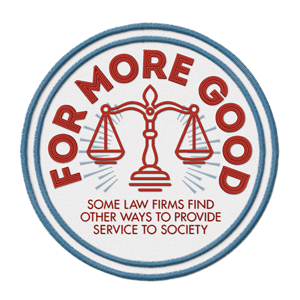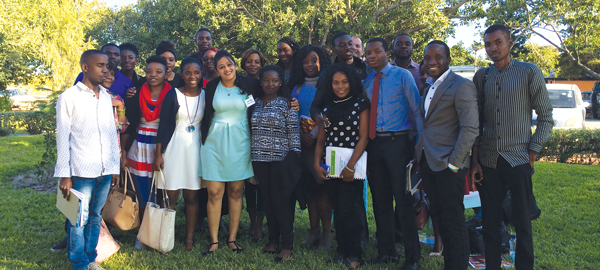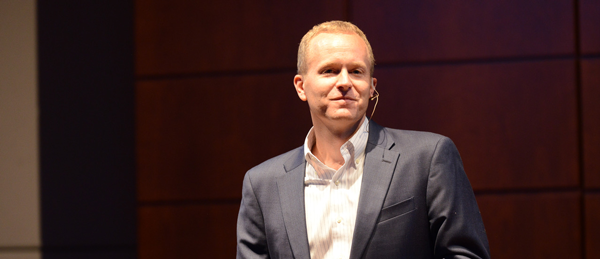For more good: Law firms find other ways to provide service to society

Photo Illustration by Steven Ravenscraft and Monica Burciaga
On a beautiful Saturday morning last May, a group of women spent the day with students planting and repairing yellow and red container gardens in a lot shared by Public School 7-Samuel Stern School and Global Technology Preparatory School in East Harlem. Some of them filled the 2,000 square feet of planters with vegetable seedlings. Others painted a bright and cheery mural on the garden wall, while others built a grape arbor.
The work at 120th Street and Lexington Avenue, an area with limited access to fresh produce, supports Edible Schoolyard NYC, a nonprofit organization that aims to teach public school kids how to grow, cook and eat nutritious foods by integrating gardening and kitchen classes throughout the school day.
The women, attorneys from Morrison & Foerster and Morgan Stanley, are giving back—but not in the traditional sense of pro bono legal work.
“It was a wonderful day, a charity day, a community service day,” says Jamie A. Levitt, chair of the MoFo Foundation, which celebrated its 30th anniversary last year. “But it was also funded with a donation to Edible Schoolyard by our firm’s foundation.”
This program—a combination of financial donations, hands-on community volunteerism and coordinating good works with clients—is emblematic of a shift in how lawyers are thinking about working for good.
evolving ways of giving back
Pro bono translates as “for good.” The American Bar Association suggests that lawyers contribute 50 hours of unpaid legal services per year as a professional responsibility to give back. Traditionally, that work was conducted on a one-on-one basis, with lawyers looking for people and causes they could help with legal work.
But how lawyers work for good now manifests in many ways, including financial donations through firm foundations, engaging employees in nonlegal service work and organizing opportunities with in-house counsel. And in some cases, working for good enhances the “double bottom line” of firms by working with altruistic businesses and organizations but charging for their services.
These charitable programs are not meant to replace pro bono service but often direct law firm donations to specific needs.
“The ABA has a definition of pro bono, and it’s legal work,” says Mary K. Ryan, an adviser and former chair of the ABA Standing Committee on Pro Bono and Public Service. “I’ve been practicing law for 35 years, and I have been hearing more about community service efforts lately—but it is not pro bono in the sense of Rule 6.1.”
Still, these “not pro bono, but for good” efforts by law firms are growing. “Not all these ways of doing good are happening at all firms, but a combination of them is happening at an increasing number of firms,” says Scott M. Curran, founder of Beyond Advisers, which advises law firms, altruistic businesses and nonprofits.
As technology makes the world increasingly interconnected, awareness of the world’s social ills grows. “With a touch of your phone, you can see all the crises around the world and all the people in need,” Curran says.

The need for donations of time and resources has grown. In recent years, many nonprofits have shut down or merged, says Marc J. Lane, president of the Law Offices of Marc J. Lane in Chicago.
“Philanthropy is overtaxed, chased by too many nonprofits,” says Lane, who teaches social enterprise at Northwestern University Pritzker School of Law. “The 50 million people living below the poverty line in the U.S. can’t count on government support. Government grants and contracts are unreliable and slow paying. Philanthropy is changing and morphing, and the law is trying to catch up and doing things in different ways.”
FIRM FOUNDATIONS
Some law firms put their money where their hearts are by setting up their own foundations that financially contribute to their altruistic missions. Greenberg Traurig topped Law360’s list of the top 10 charitable law firms during 2014, donating more than $7 million. Sidley Austin ranked second with $6.5 million, and MoFo was third with $4.4 million in giving.
Funding for the MoFo Foundation comes from mandatory donations from partners plus voluntary contributions by associates and staff. As one of the first law-firm-affiliated charities, the foundation has donated about $48 million since its inception. Contributions range from $14 to $322,000.
“The whole mission of the foundation is to enable the people at MoFo to focus their charitable giving,” Levitt adds. “Maybe they are already connected to an organization and volunteering there.”
Every year, each office is given a portion of the collected funds, prorated by the size of that partnership, Levitt says. That office’s staff suggests meaningful local charities: The Los Angeles office donates to the Children’s Burn Foundation in Sherman Oaks, California, while the U.K. office gives to the Richard House Children’s Hospice in London.
Proposed grantees are vetted to ensure they are 501(c)(3) charities, do not have discriminatory practices and fall in line with the MoFo mission. “As long as it fits, it is funded,” says Levitt, who also co-chairs the firm’s commercial litigation and trial group.
Grant recipients often focus on work to help children and youths, which received $1.6 million of the foundation’s 2015 donations. A similar amount was awarded in 2016.
When a natural disaster strikes, such as Hurricane Katrina or the Fukushima tsunami in Japan, the foundation’s board matches employee donations.
“We will pick the most useful organizations that can best use the funds,” Levitt says. In 2015, the foundation matched more than $100,000 in gifts.
MORALE BOOSTER
Every few years, the foundation gives special project grants to support or help create new nonprofits geared toward disadvantaged children. In 2012, the foundation gave $250,000 to iMentor in New York City to help launch its College Ready Initiative, which encourages high school kids from low-income communities to become first-generation college students.
Greenberg Traurig has two separate philanthropic foundations funded by shareholder and attorney donations. In 2015, the firm hosted meetings with partners in every U.S. office and discussed increasing donations.
“And that’s paid off,” says Brian L. Duffy, the firm’s Denver-based CEO. “Part of our core values is giving back to the community with our time and treasure. ... It improves the morale of our employees and the quality of our communities.”
Many lawyers in larger firms spend their days working on financially driven clients, Duffy says. “But we want to feel good about what we’re doing when we get up in the morning,” he says.
Legal aid and education are common focal points for money and manpower. “We think pro bono hours and philanthropic financial support work great together,” Duffy says.
The Greenberg Traurig Holly Skolnick Fellowship Foundation is dedicated to funding two-year fellowships for young lawyers via Equal Justice Works, a nonprofit that supports aspiring public interest lawyers.
“If you take a good associate who is working 100 hours a year on a pro bono project, you can make an impact—somewhat,” Duffy says. “But if you take a full-time lawyer working 2,000 hours on a single subject, they will have a more significant impact.”
Each year, potential fellows submit proposals in a very competitive process, says Mia Sussman, Equal Justice Works fellowship director.
Sponsors such as the Skolnick foundation, Sidley Austin and Morrison & Foerster pick fellows to fund. Greenberg Traurig has sponsored the most fellows of any firm, supporting 142 since 1999.
Current fellow Kwame Akosah, a 2015 Fordham University School of Law graduate working through the Brennan Center for Justice in New York City, aims to ease restrictions on restoring voting rights for those who have left prison.
“I can barely describe how important this fellowship is to me,” says Akosah, whose internships at the American Civil Liberties Union and the New York Mayor’s Office also focused on voting rights. “I often idolized the Brennan Center and their clout and importance, and I hoped one day I would find my way here. Little did I realize I’d be here so quickly after law school.”
Equal Justice Works strives to ensure that a pipeline of talented and trained lawyers are involved in public service. “There is a crisis for funding for civil legal aid, and there are no funds for entry-level staff attorneys,” Sussman says. “One of the only ways they can go into those careers is through one of these fellowship programs.”
With his fellowship funded by Greenberg Traurig and the Ottinger Foundation, Akosah now sees how his pro-social work can continue. “Now I have an opportunity to pursue voting rights work as a career,” he says.
GLOBAL GIFTS
New Perimeter, a nonprofit established by global law firm DLA Piper, acts not as a foundation but as an organization to manage multiyear projects that use staff and clients from around the world.

Morrison & Foerster attorneys volunteer at an Edible Schoolyard NYC event. Photo Courtesy of Jamie Levitt
“Our mission is to offer long-term pro bono legal assistance to give access to justice and develop sound legal institutions,” says Lisa Dewey, pro bono partner and director of the nonprofit. “A lot of those projects have been in developing or post-conflict countries that are underserved places.”
As of November, over 800 DLA Piper lawyers from more than 60 global offices have devoted at least 120,000 hours to New Perimeter projects in 33 countries, including helping the United Nations draft laws to create the court and prosecutorial systems in Kosovo in Southeast Europe.
New Perimeter frequently supports law schools in developing countries. At the University of Zambia School of Law, DLA Piper and in-house counsel from one of its clients, German pharmaceutical company Boehringer Ingelheim, conducted a weeklong writing workshop last June to help students pass the bar exam. BI lawyers from three countries helped teach more than 100 Zambian law students.
“The lawyers from BI and DLA broke down the formula and helped us understand it. I saw an improvement in my grades,” says student Suwema Banda from Zambia’s capital of Lusaka in Southern Africa.
“What touches me is how motivated and hardworking and talented students are,” says Sara K. Andrews, New Perimeter senior international pro bono counsel and assistant director. “Many are from extremely humble backgrounds. A number of students come from places where their entire village pitches in for the student to go to university.”
Pro bono is not part of the culture in India, so Kruti Shah was eager to soak up the teaching experience.
“This was the best experience I could ever have,” says Shah, legal counsel at Boehringer Ingelheim in Mumbai, India.
“They were looking for help with legal language but also things like grammar. I am also from a developing country, and they wanted to know everything about India—food, spices. The conversation moved way beyond law.”
The experience continues beyond the five-day program. “I have received 30 emails from students there to tell me how special these five days were,” Shah says. “Many have wanted to do an internship in India. I’ve had seven requests.”
ORGANIZING LOCALLY
In the United States, more firms are employing pro bono coordinators. Anne Geraghty Helms, DLA Piper’s director and counsel of U.S. pro bono programs, organizes lawyers at the firm and in-house corporate counsel to help out on good works.
“For a few years now, pro bono resources have been shrinking,” Helms says. “We have a responsibility, a real call to action to work together.”
The Woodlawn Legal Clinic in Chicago provides free legal services and referrals for issues that include eviction, divorce, child support and expungement of criminal records. Helms has brought in her firm’s lawyers and in-house counsel from clients such as Discover Financial Services.
“More and more what I’ve seen from the leadership of corporate clients and in the firm world is this recognition that we are all lawyers and in it together,” Helms says.
On Wednesday afternoons a few times per year, Kelly McNamara Corley, executive vice president, general counsel and secretary at Discover Financial Services, makes the hourlong drive from her office in Chicago’s northern suburbs to the Woodlawn clinic.

Mumbai lawyer Kruti Shah (blue dress) worked with Zambian law students preparing for the bar exam. Photo Courtesy of Kruti Shah.
“Every time I go down there I really feel I help someone,” she says. “You carry that feeling around and go back to help more people, and then go back again. It is gratifying.”
One evening, an elderly man with a series of respiratory health problems came to Corley in search of help with his landlord.
“He brought in pictures, and from every angle of the room, there were rats—six rats on the kitchen counter, in holes in the wall, everywhere. It was horrific,” says Riverwoods, Illinois-based Corley. “We made some suggestions, like how to sharpen communications to make sure his landlord understood he knew his legal rights. We suggested some resources, like temporary housing with other social service groups.”
DLA Piper provides training for volunteers, including an overview of the most common legal issues—such as housing, family law and benefits—seen at the clinic.
“It refreshes points I learned in law school that I haven’t used in a while,” Corley says. “Without the partnership with DLA Piper, I might not have felt comfortable going to provide this type of aid.” Although neither DLA Piper nor Discover Financial Services has a foundation, they do supply financial support for pro-social causes. DLA Piper helps fund legal aid organizations, while Discover funds fellowships for young lawyers interested in public law.
The financial service agency is building its own pro bono projects, with 92 percent of its legal team now participating in efforts that include helping first responders set up their wills.
“In the corporate world, you have to make sure you have the time, that it’s OK with your employer,” Corley says. “Folks here, our people, will do this work on Saturday, or we’ll take a day and the department will go help out. And that’s quite a thing.”
PROFIT FOR GOOD
Socially conscious business models have been popping up to replace traditional nonprofit and philanthropic entities that have been suffering from financial stress and uncertainty.
Although altruistic business models have existed for decades, lines between a traditional charity and for-profit companies that work for social good are increasingly blurring. As a result, the private sector is evolving as more companies create innovative ways to make profits while being socially conscious, Beyond Advisers founder Curran says.
An example includes Toms Shoes, which donates a pair of footwear to someone in need for every pair sold.
“They are trying to solve a social problem through business, but make no mistake—they are a business,” Curran says.
These for-profit social enterprise entities are much more visible, says Gene Takagi, managing attorney of Neo Law Group in San Francisco. Facebook mega-couple Mark Zuckerberg and Priscilla Chan’s company for investment and philanthropy, the Chan Zuckerberg Initiative, “is money going from one pocket to the other. It’s not going directly to a charity, but it is pledged for the public goods,” Takagi says.
There can be a business motive: Millennials often base purchases on a company’s pro-social works.
“This generation doesn’t see contradictions between doing good and doing well,” says Kyle Westaway, managing partner of the Brooklyn law firm Westaway. “The idea of you have to be a martyr or you have to work for ‘the Man’ doesn’t fly for them.
“The traditional bifurcation of ‘You make money here, and do good there’ is a model that doesn’t allow us to think as creatively about solving some of the most pressing social issues,” he says.
The shift toward being paid for pro-social work emerged as new legal forms evolved, Takagi says. For example, the benefit corporation—also known as a B Corp.—must have as its purpose the creation of a direct public benefit.
And the low-profit limited liability company, or L3C, must have an explicit primary charitable mission, and the production of profit or appreciation of capital cannot be a significant purpose.
But unlike a charity, the L3C is free to distribute the profits to its owners.
“Social good or work other than financial motive is part of these organizations’ DNA,” Takagi says.
PRO BONO BUT PAID
Some firms—typically smaller shops—see their mission as helping society by doing paid work for socially conscious clients, including nonprofits, philanthropies and social entrepreneurs. Takagi worked as a lawyer on the change in ownership structure for the Burning Man Project, in which the company that housed the event was transferred to its public charity. The law firm was paid for its work.

Scott Curran. Photo Courtesy of Scott Curran.
“The idea of Burning Man was a social enterprise to further the social community, the environment and the artistic message,” Takagi says. “It was a chance for us to help the founders and directors understand what it meant as a charity.”
Often, boutique firms such as Neo Law Group help altruistic startups determine the best structure as they launch, then operate as in-house counsel once things are up and running.
To stay accessible to smaller clients, these firms develop different pricing structures. Neo Law Group has a tiered format.
“We have a discount rate for our charitable clients,” Takagi says. “Private foundations might be paying more than a small public charity.” And the firm has no billable hour requirement. “We want to be accessible to the general public. We don’t have a minimum number of hours clients must use us,” he says.
At law firm Westaway, the structure is different from traditional firms. It operates on a hub-and-spoke model, with its founder and director of operations working as the hub.
“We build teams around projects, and no one is on the full-time payroll,” managing partner Westaway says. “What we’ve learned is clients want a good value, but they really want cost certainty. They need to eliminate question marks. We have simple, clear billing and talk about it up front.”
Wilkinson Mazzeo, a San Diego law firm, keeps its overhead low by working in a collaborative office space with about 20 other businesses. It also uses a flat-fee system, with rates for some nonprofits lower than rates for for-profit clients.
The firm does not charge for routine communications with clients, and it gives a discount to female entrepreneurs’ initial project with the firm, such as forming a limited liability company.
“We like to think we are affordable, approachable and we educate our clients,” says Sam Mazzeo, a partner at the firm. “The value they get is pretty good.”
At ABA standing committee member Ryan’s firm, Nutter McClennen & Fish in Boston, they will consider working for reduced rates for a nonprofit. “ABA Rule 6.1 does provide for working at substantially reduced rates as pro bono,” she says.
Mazzeo says it’s a win-win to have paying clients engaged in socially rewarding work. For example, his firm has worked with jewelry company the Giving Keys in Los Angeles, which hires formerly homeless people and those transitioning out of homelessness.
“When we meet the people and see them working, it feels great,” Mazzeo says. “It’s been a gut check for us. We are working for nonprofits and creative people, but they are paying. And it feels good.”
Mazzeo likes the notion that his firm’s work is supporting people’s efforts for change. “We’re behind the scenes, helping them make decisions,” he says. “I’d like to think some of the social impact they have can be attributed to us in some small way.”
Julianne Hill is a freelance writer based in Chicago. This article originally appeared in the February 2017 issue of the



